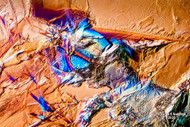Beta-Alanine and L-Glutamine Under the Microscope
Apr 6th 2020
Beta-Alanine and L-Glutamine Under the Microscope
Harald K Andersen lives in Norway and captured this image of the amino acids Beta-Alanine and L-Glutamine under the polarizing microscope. He used a 10x objective and 20 images stacked using Zerene Stacker PMax.
What is Beta-Alanine?
Beta-alanine is a non-essential amino acid that is produced naturally in the human body. Beta-alanine aids in the production of carnosine, a compound that plays a role in muscle endurance in high-intensity exercise.
Why do people take Beta-Alanine?
People take beta-alanine supplements in the hopes of enhancing sports performance and endurance. Since muscles contain carnosine, it is thought that higher levels of carnosine may allow the muscles to perform for longer periods before they become fatigued. Since beta-alanine is one of carnosine's main ingredients, beta-alanine supplements are thought to boost the production of carnosine, and in turn hopefully boost sports performance.
What is L-Glutamine?
L-Glutamine is an important amino acid with many functions in the body. It is a building block of protein and a critical part of the human immune system. L-Glutamine is found in foods such as eggs, beef, milk, tofu, rice and corn. L-Glutamine has been studied and is thought to reduce muscle soreness, improve recovery after intense exercise, and boost the immune system.
Why do people take L-Glutamine?
People take L-Glutamine supplements to improve immune system health and for improved recovery after exercise. If the body uses more glutamine than the muscles can make during times of stress, muscle wasting can occur. This happens to people with HIV/AIDS, or other patients receiving chemotherapy treatments. Taking glutamine supplements might keep the glutamine stores up and improve the immune system.
Microscope Questions?
If you have any questions regarding polarizing microscopes or image stacking, contact Microscope World and we will be happy to help.





